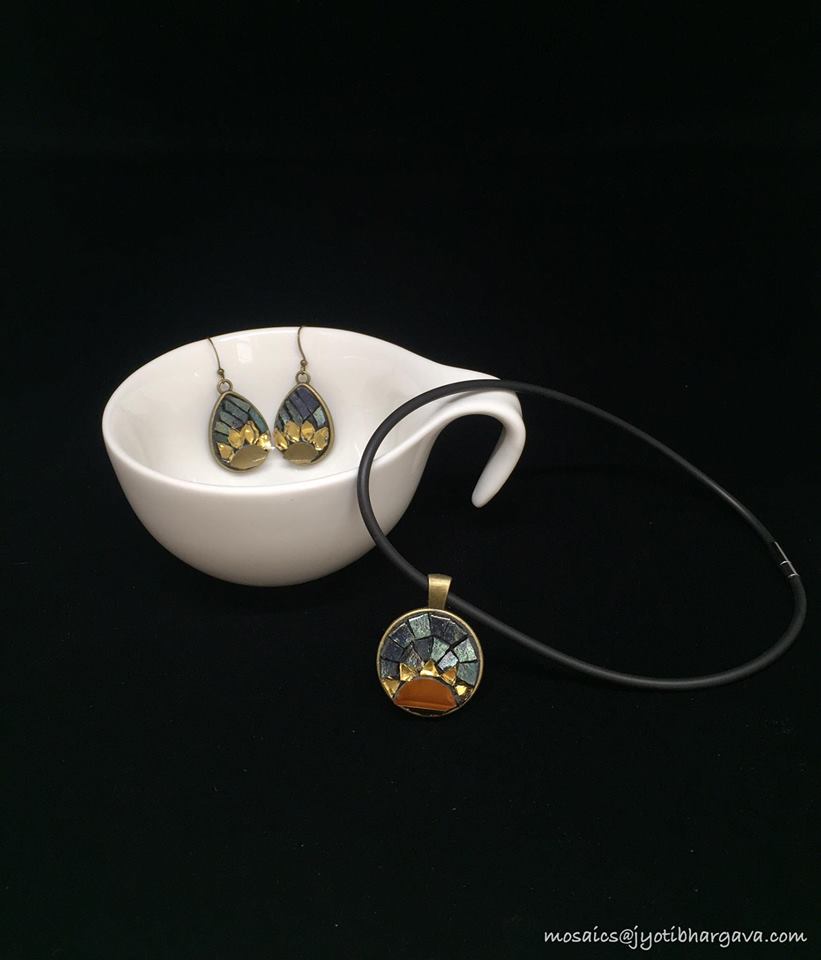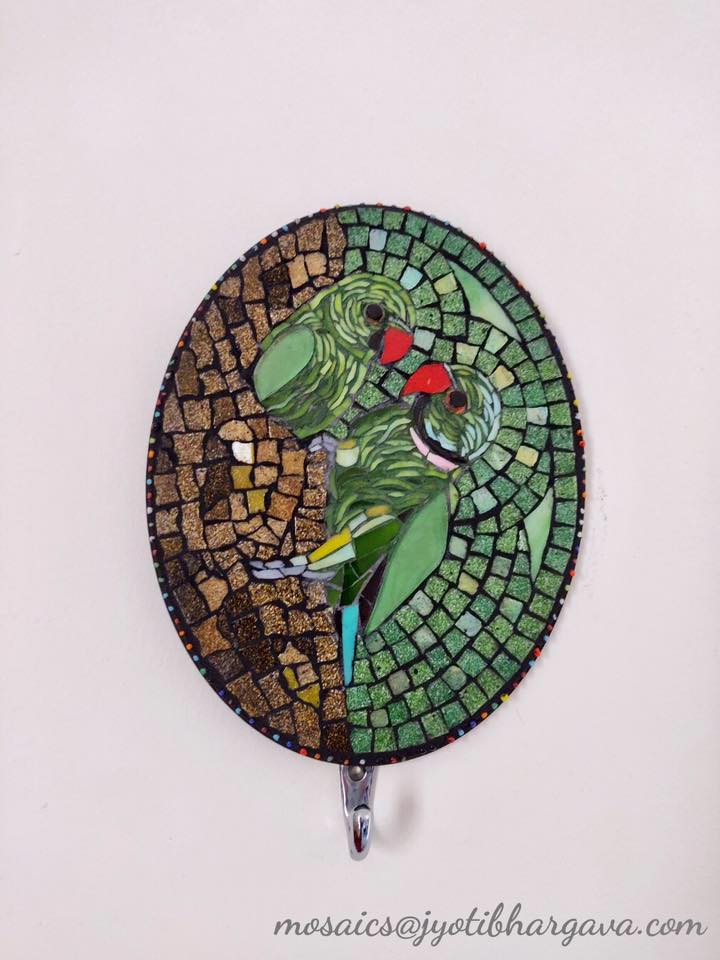I’ve long wanted to jot down my thoughts on why I make mosaics or what this art means to me. This post gives me that opportunity, and I hope I can gather most of my sentiments while sharing some here.

How…
I’m over 50, and straddling multiple roles of a mother, wife, home-maker and a part-time business manager to my husband’s tech consulting work. Being an early entrant into a full-time job, I forced myself to get organised with tasks on hand but managed my academics in a rather ad hoc way. The undergrad Commerce degree came through while being in a full-time administrative job and much later, at age 40, I studied for a Master’s in Human Resources management. In all this, my love for reading continued, I got married, had a son, and found Net based research to be my regular pursuit. Being around my geeky spouse who seemed to be on a regular quest for learning, helped get familiar with a personal computer rather early for India and adopt a tablet or a Kindle or Alexa as a natural progression. My reading on the Net would be focussed on the interest or requirements of that time, but my teenage love for drawing and hand-crafting décor items became a faint childhood memory. I’d use my sense of aesthetics to choose and buy affordable art for my home or design my simple clothes but the thought of creating appealing art felt too far-fetched. I’d tell myself that I didn’t have a fine arts education so how could I make something nice enough to want to delight an onlooker!
Then about 4 years ago, the craft of making mosaics came into my purview and made me think differently. Four years prior to my initiation, I’d seen a wrought iron table in a host’s balcony in Goa and found myself attracted to it. The host had simply described it as something made by a local artisan who had been hard to locate to do more such work. I wasn’t sure of the name of this rather crudely—but also charmingly—assembled artwork. I remember it as a composition of solid colour ceramic tiles that were possibly broken by a hammer and stuck to a metal table base with white cement filling the gaps in between. Back in Gurgaon in India, where I lived, some 4 years later, I came across a sale post in a Facebook group where the creator had shared some colourful functional items like coasters and trays and called them mosaics. She had invited members to buy those items at a fare. I figured from her FB Page that she’d learned to make mosaics while in Australia. It occurred to me then that even though more mindfully composed, these were created on the lines of the mosaic table of my distant dreams. It’s a bit of a long–winded story as to how I got to finally enter the world of creating mosaics, and its details aren’t all pleasant. Suffice it to say that the last 4 years have seen me reading up on this art, pleading with friends travelling from the US to fit my tools and books in their luggage, and broadening my understanding of the art of mosaics.
What…
Mosaics are known to some as an assemblage of certain materials on a backer to create a composition or just a splash of colours. The ancient Romans used carefully cut stone squares or trapezoids to create floor mosaics to make those formations long–lasting. Particular attention was paid to the andamento or the flow of such geometric shapes. Later, this artwork reached the churches where elaborate life-like compositions were created on the Christ or Mother Mary with coloured stained or gold-leaf glass presumably to fascinate the church visitors. To this date, I’m told that amazingly ornate mosaics can be seen in European or American churches. As the art of making mosaics reached the artist studios in the west, the otherwise fixed rules on the shapes or flow of materials went through innovations, and the outcomes were varied, vibrant, experimental as also gorgeous! Artists drew inspiration from nature, folkart, quilting, embroidery and more to translate their ideas into coloured glass mosaics. Some introduced broken or carefully cut floral elements from crockery to create more unique stories with their mosaics.
My Mosaics…

I started with 20x20x4 mm vitreous glass tiles to make my first few mosaics. It helped that I could manage them with one tool alone, a pair of wheeled glass nippers. The tool wasn’t available in India so after getting 4 different brands shipped from the US, I finally had one that felt good in my hand and had stable blades. In a year’s time, I found myself welcoming challenges of cutting hard 4 mm tiles into intricate petals and small trapezoids—a shape many beginners tend to avoid. Soon, however, I noticed the predominant use of stained-glass sheets by mosaicists in the west to create bigger floral or other shapes so my interest in including them in my compositions grew. I approached a few Tiffany style stained–glass artists in my city to teach me to cut sheet glass but didn’t get their favourable response. Challenges of managing bigger and more expensive sheet glass are many as their tools are different and need a determined practice to get good with their use. It’s only in the recent times that I found a wonderfully skilled stained–glass artist who guided me through the making of a small glass carpet. I need to practice cutting sheet glass more and more to get comfortable with this material…
Meanwhile, I remind myself that my love for mosaics really got started through that table that had used ceramic tiles so I must keep getting good with this material. All my reading and research on tile cutting realised when a mosaicist from the UK was commissioned to make a wall mural in Gurgaon, my city in India. I went and volunteered for that project for a couple of days and felt confident about cutting this hard and thick material. I do love how solid colour and printed ceramic tile mosaics look once grouted but I don’t always welcome the gear I must put on while cutting tiles. The minimum being a nose mask and protective eye glasses and the ideal being a head cover in addition. Ceramic tiles emit dust that becomes bothersome to deal with but my love for the material inspires me to want to keep working with it.
As I’m seeing more work, my learning list has been expanding. Including crockery focals into my mosaics has long interested me but I haven’t cut much crockery yet. I dream about cutting out flowers and leaves from ornate cups or using the curvature of plates to my advantage to create petals or flowers. This form of mosaics is called Picassitte or ‘stolen crockery’ in French. Then, being a bird-watcher, I’ve wanted to make many bird mosaics. While mosaicking a pair of parakeets, I found their eyes to be particularly tricky as the mosaic was small. It was meant to be a wedding present so had to be mindfully made. I settled on layering glass ovals but decided that I want to be able to create more realistic bird eyes by fusing bits of glass in a glass kiln. An electric kiln imported from the US costs a huge sum so I’ve acquired a small Microwave kiln for experimenting with. Presently, I’m going through Youtube videos on this kind of glass fusing and frenetically making notes…
In my journey this far as a mosaic-maker, I’ve wanted to share my learning as I’m plodding along. I’ve found Facebook to be a helpful space to follow artist pages and to join groups where mosaicists ask or answer questions. Earlier, I would follow individual artist blogs but there weren’t many, and now I find that whoever is blogging is sharing links on their FB Page. To return the favour, I’ve opened a learners’ group oriented towards learning and practising the art in India. I found a lot of secrecy maintained by early practitioners I found in India, so I thought I would unravel this mysterious art to others. Since I can’t be sure of a platform like Facebook to maintain its current structure or rules, I’ve created a simple website where I share leads to resources. Biggest of all ‘small’ initiatives by my parameters has been to help establish a supply source for those in India for tiles and tools. A tile manufacturer I came across on Amazon responded to my queries and a year later, obliged by setting up an e-commerce website to sell glass and ceramic tiles in small quantities. Upon prodding, they included the essential tools imported from Taiwan or elsewhere so a small level studio artist in India now no longer has to search high and low for the right tools of trade.
More unusual materials and techniques have been coming into my mosaic ambit but in closing, I should simply share my heart-felt wish here…that my hands and eyes should keep working enough to enable regular mosaic-making so my connect with this art consolidates further through my remaining life.

Jyoti Bhargava is a mosaic-enthusiast, an irregular blogger, a regular Net researcher, a recluse but a committed business manager. She believes in good Karma and perpetual learning. Her mosaic-based writings can be read at mosaicindia.in.

